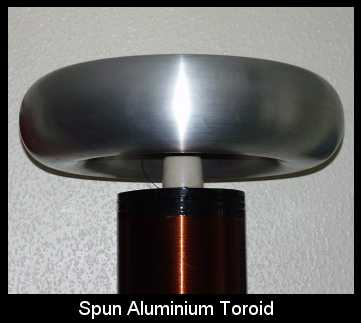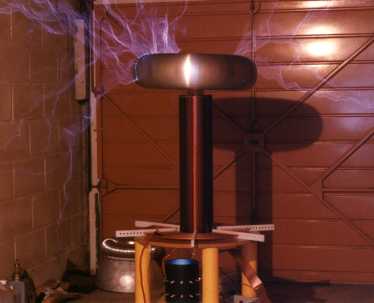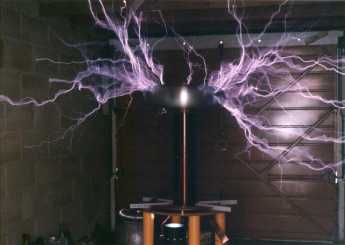

Once the MMC had been repaired, the coil was running great again. I was back to good old NST power and successfully impressing friends and neighbours. I discovered that the people next door were getting some dotted white lines on their TV when the coil was running in the garage. They said that it was not a problem ('That's a relief!') and they did enjoy the coil show I gave then.

Mike T. had just taken delivery of his brand new spun aluminium toroid (picture above of toroid on 10 inch secondary), a most beautiful object! The trouble was that we had nowhere to fire up his large coil and we were itching to see this King of top-loads in action. It didn't take too long to come up with an alternative - 'Let's run it on your coil, Steve!'. 'Cool!'

It looked a little big on my little coil (6 inch secondary) but it's not the size, it's what you do with it that counts! We set it all up, turned on the power and then started to wind up the variac.
Usually with my coil, the gap starts to fire and small streamers appear at only a quarter of full power. I wound the variac all the way round to the max and nothing happened!! The size of the new toroid was not much greater than some home made ones we had successfully used in the past, so we thought the tap point on the primary must be pretty close to tune. We moved it in a turn and tried again. Nothing happened,again, until we reached full power and then it let rip! No more than a single streamer was visible at any one time. We were at the very limit of what topload my coil could break out from.
We managed to measure one of the streamers when it hit the metal garage door at a spot we could remember. Max length was 63 inches!

(Long exposure times make a great picture. Check out the Photo Gallery for larger pictures)
We knew that a smooth topload would break out at a higher voltage than our home made ducting toroids but we always thought that the spark gap would made a noise and fire, even if no streamers broke free of the top. With no gap firing there could be no energy transfere between the primary and secondary circuits, and therefore there should be no difference in the gap action from a simple change to the topload. We conclude, therefore, that there was gap action but it could not be heard over the background noise of the blower. I must look into this further.
The coil was Rockin' and Rollin', very impressive! We started to get strikes to the primary coil. Ten seconds later the coil died!

After some investigation, we discovered that the NST had died. One of the 5kV terminals was dead! :-(
The transformer is potted in some sort of epoxy resin. I started chipping away at it to see if the windings could be exposed for possible repair work but this proved impossible.
'Anyone got a pole pig for sale?!!'